Architects’ Showcase: Hassell prioritises collaborative learning with Adam Smith Building
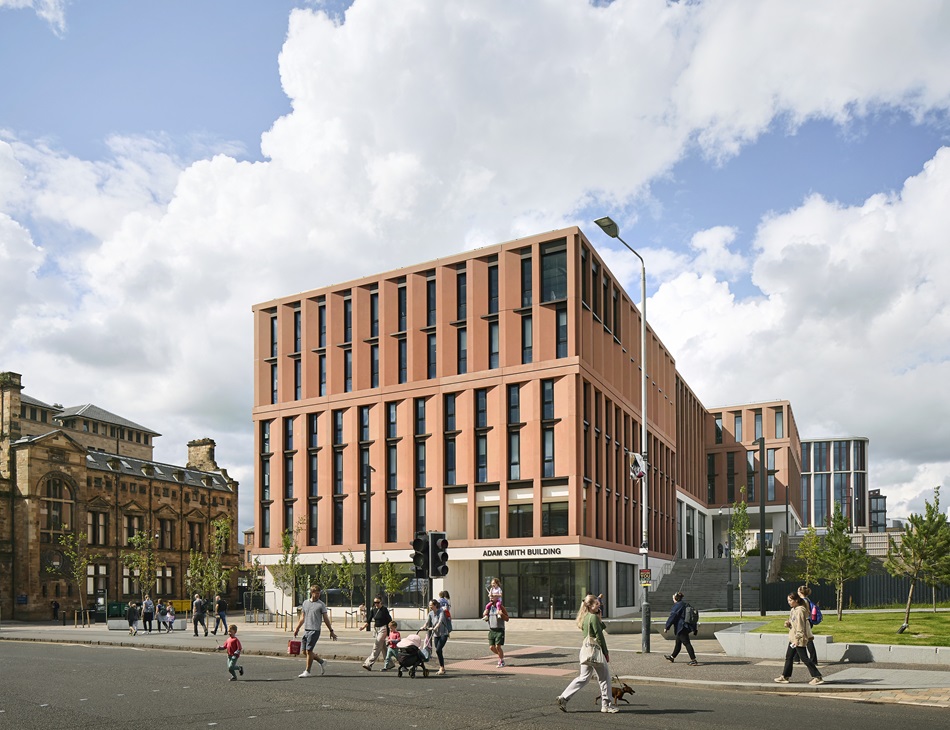
Global design studio Hassell has completed the final phase of the Adam Smith Building, the new 11,500 sqm flagship site of the University of Glasgow’s Business School.
Named for the father of economics, the Adam Smith Business School aims to develop enlightened, engaged and enterprising graduates who become global leaders in business for tomorrow. It is supported by a transformational, state-of-the-art teaching and research building.
The new business school and postgraduate hub, now open and in use, promotes collaborative research and interdisciplinary practice. It achieves this through its division into three interconnected structures, each supporting teaching, research, and professional services – all of which place business skills and engagement at the heart of the postgraduate experience.
Designed to foster collaboration and a sense of community for students, staff and visitors – through interconnected open spaces and contemporary interiors – the business school is expertly situated within the rich heritage of the University of Glasgow campus and features a unique masonry façade.
Standing at six storeys, the new building ensures that the business school’s postgraduates have a dedicated space to work across academia, research, innovation and industry-leading to truly world-changing outcomes and cementing the university’s position as one of the world’s most progressive and enterprising centres for business.
The Adam Smith Business School consistently ranked within the top 100 schools in Europe, has been designed to eliminate traditional barriers between students and staff, creating a collaborative workspace that fosters open discourse and promotes a sense of community. Founded in 1451, the University of Glasgow is one of Europe’s oldest educational institutions and holds the second-largest cohort of postgraduate students in the UK. The school sits within the Gilmorehill campus expansion, based in the heart of the city’s vibrant West End.
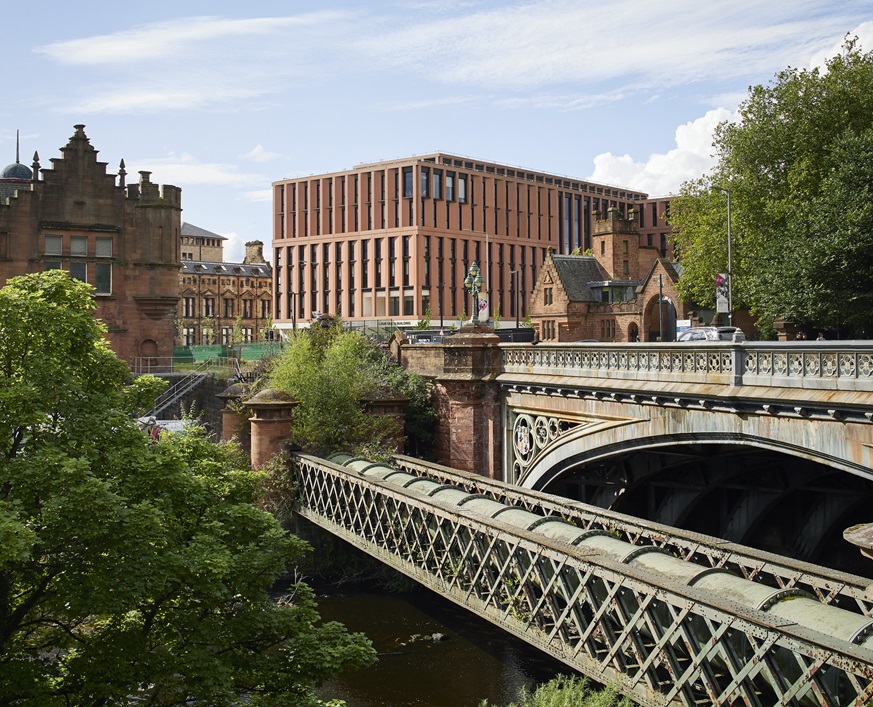
In 2017, the university received planning approval for an expansion and redevelopment of the Gilmorehill campus as part of a £1 billion development programme to include a mix of research, teaching and public spaces.
Contrary to a mass, unified block, Hassell’s exterior design features a unique masonry façade emphasising the building’s materiality, which sensitively situates the business school within the campus’ rich cultural heritage. With a colour scheme that harmonises with its historic environment, the building prioritises modern interiors that foster connectivity and collaboration through various open central spaces.
Development of the state-of-the-art research and teaching building began in 2017 and the final phase of the project completed in December 2023. The building is now in use by students, staff and visitors, and has been operational since September 2023. The creation of the new business school is the fourth major building in the first phase of the University of Glasgow’s campus redevelopment.
John O’Mara, principal at Hassell, said: “The Adam Smith Building transforms educational and commercial partnerships, creating world-class facilities at the University of Glasgow for future business leaders. Embracing Adam Smith’s legacy, the new school fosters industry-academic collaborations and propels research and innovation, amplifying the University’s role as a leading global business hub.”
Professor Eleanor Shaw, head of the Adam Smith Business School, said: “I am delighted with our new building. It is a beautiful, light open space that offers many opportunities for delivering excellent learning experiences for our students, and collaborative, welcoming offices, meeting rooms and spaces for our staff and external partners.
“The opening of the cafe on the ground floor will benefit our community, offering a welcoming place for staff, students, partners and the local community to come into the Adam Smith Business School, enjoy a refreshment and have a look around our fabulous new building. I very much look forward to spending time in the cafe and to welcoming staff, students and visitors into our new building.”
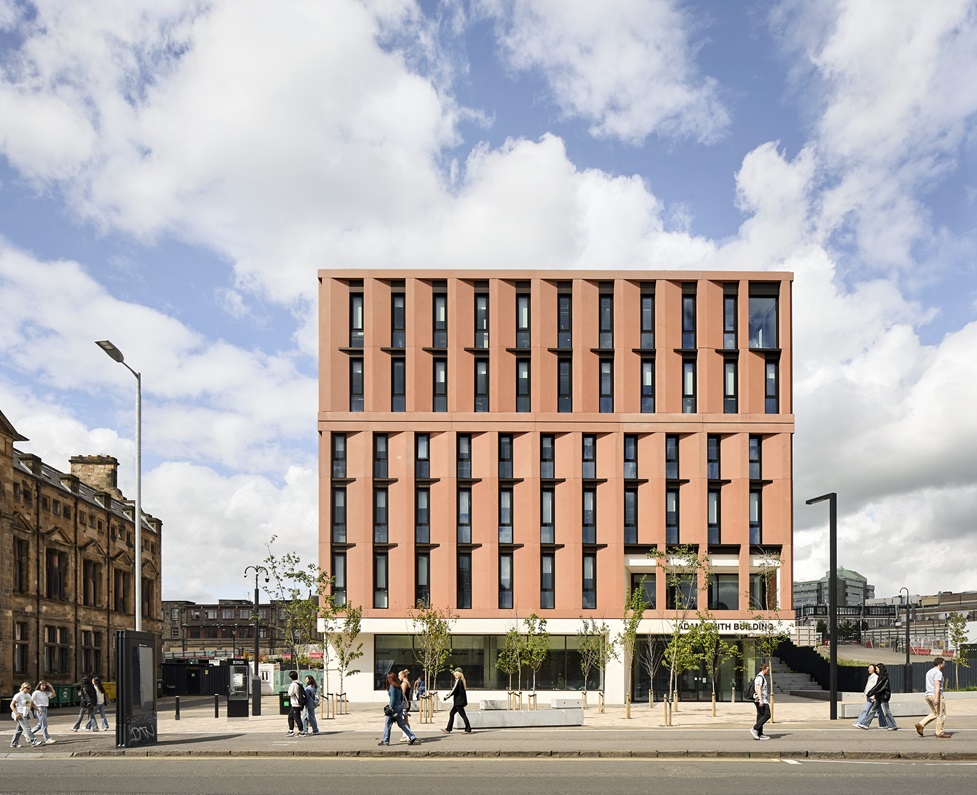
Site
The building provides world-leading facilities for the Adam Smith Business School from its site on the Gilmorehill campus, located in Glasgow’s vibrant West End. Home to a £1 billion campus development and expansion programme, the building is a key anchor of the new University of Glasgow masterplan and serves as a campus gateway. Spread over six floors, the building has a gross internal area of 11,500 sqm and features academic offices, workspaces, and state-of-the-art teaching spaces for both business and other taught courses. An expansive central atrium acts as a collaborative breakout space for students and faculty, and specialist hubs for subjects such as fin-tech are also on offer.
Approach
Two key points of entry for the building - strategically located on the main access routes to the university - celebrate the building’s position as a gateway between the city and the Gilmorehill campus. The southern entry on the ground floor faces out towards the city to welcome visitors arriving from Dumbarton Road, with the northeastern entry facing towards the campus to meet people arriving from the central university site.
Building form
The building form considers both the site’s topography and the business school’s functional interior spaces while incorporating a singular materiality to ensure a balanced design. The form is created by using ‘stepping blocks’, which involve subtle shifts in planes to create private areas. These spaces harmonise with the open atrium, which fosters natural interactions between professional visitors, students and staff.
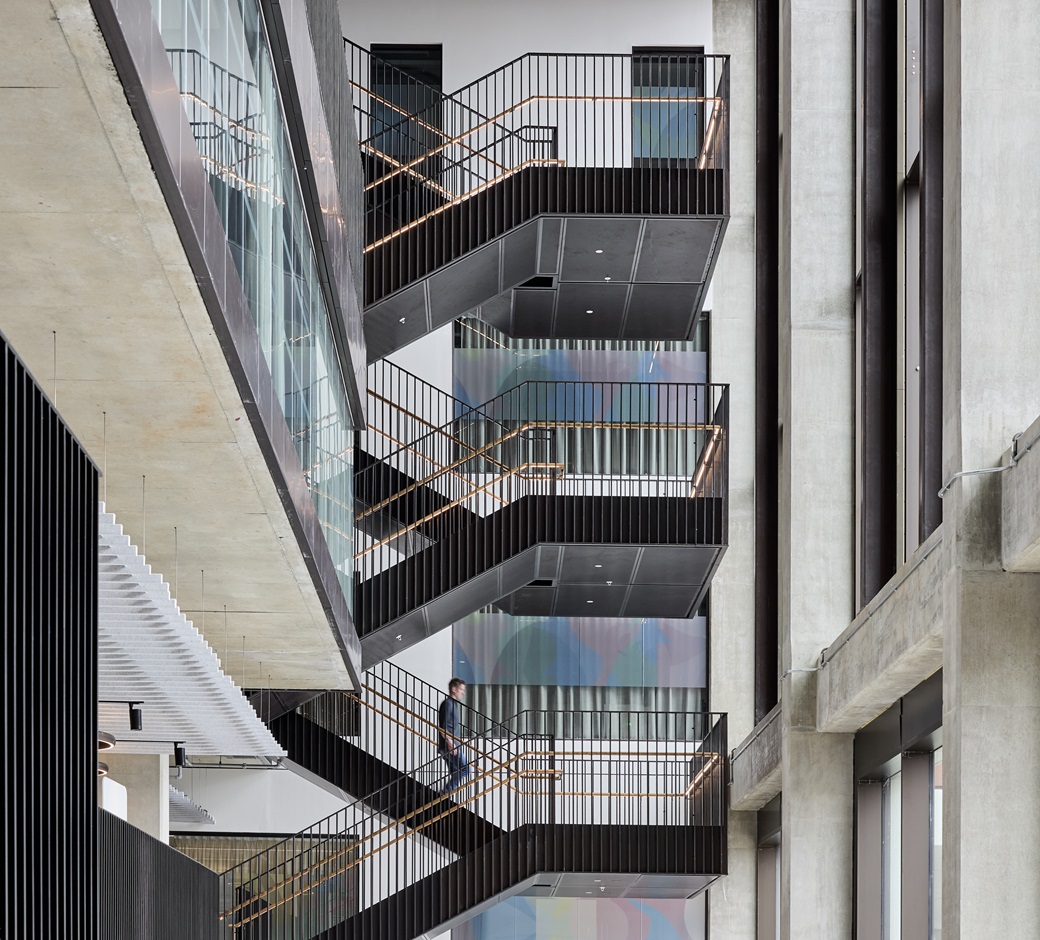
The ground floor features an additional podium, intentionally contrasting with the structure above, giving the impression of the building recessing into the landscape and appearing to float. Extensive glazing enhances this effect by breaking down the solidity of the base of the building, contributing to a dynamic, inviting civic presence at ground level.
A series of interactive features were identified around the plinth to highlight the relationship between the interior, exterior, and the plinth itself. The project’s main goal - fostering collaboration and connection among students, visitors, and staff while creating a welcoming space for the broader community - is achieved through these human-centred features. From wayfinding elements to inviting spaces for rest or views, each feature encourages meaningful, accessible interactions. The building’s design is thoughtfully integrated into its surroundings, making it a natural extension of the local environment.
Façade
The façade of the Adam Smith Business School is crafted predominantly from masonry to create a solid, civic presence via a façade that wraps the building. As the key structure defining the Southern Gateway into the university site, it was crucial to Hassell’s brief that the business school sat coherently beside Anderson College and the nearby context of Kelvinhall campus. To achieve this, Hassell emphasised a vertical design within the masonry framework, giving the building a distinct and unified identity.
A podium of one-to-two storeys in height has been conceived as part of the design - a solid plinth with substantial key moments of openness and transparency. The difference in tone and texture of the podium façade creates a unique identity, while the limited palette of cladding types simplifies and strengthens its architectural expression.
The masonry façade varies across the site, adapting to the changing topography with three cascading elements that break up the vertical structure. For example, on New Moy Street, the vertical design is split at the sixth level, where the MBA suite, terrace, and a large meeting room are located, featuring floor-to-ceiling windows for panoramic views. In contrast, the central atrium remains uninterrupted, with its full vertical expression maintained. The upper two levels are divided to prioritise long-range views, adding movement and interest to the façade, giving the building a dynamic presence from all angles.
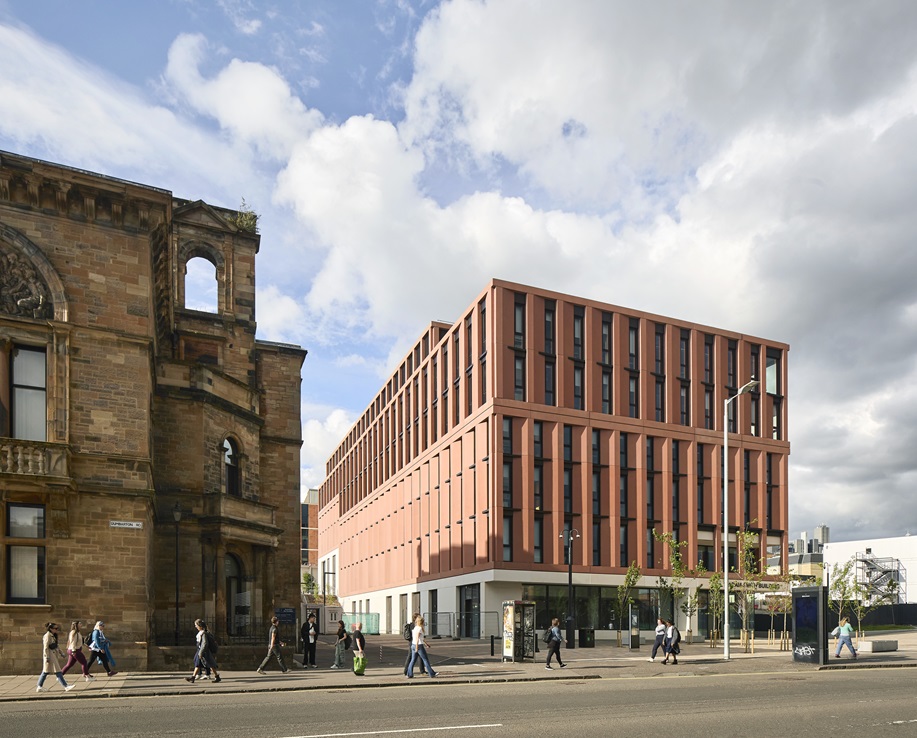
Internal layout
The most important element of the design brief for the Adam Smith Business School was its internal design layout, which aims to facilitate collaboration and interaction between all the groups that would use the new building, from students to staff and professional visitors.
Hassell conceptualised this layout through three programmatic ‘stacks’: the southern zone for research and academic work, the northern zone for teaching and learning, and a central collaborative zone to blend both areas together at the heart of the business school.
The central stack contains all collaboration spaces that are likely to attract most building users, leading to instances of organic, informal interaction and enhanced connection between groups. Hassell’s implementation of a central atrium allows these stacks to be clearly defined, with light wells throughout that open the space around each zone. The internal layout design enables greater integration between research and teaching - allowing for collaborative events that can expand to include the outside via large sliding doors to the east - supporting a community of creative, curious, and critical thinkers benefitting from practice and research-led learning methods.
Interconnected learning
Organised into these three interconnected ‘stacks’ - each highlighting research, collaboration and teaching - the Adam Smith Business School offers improved opportunities to consolidate postgraduate activities within one building, enhancing the school’s ability to mobilise and capture large-scale professional and interdisciplinary research projects. A reconfigurable space called the Hothouse hosts industry-led activities, including entrepreneurial hack-a-thons, workshops, careers events, and student-led societies, offering valuable opportunities to refocus and scale up the business school’s engagement and networks. Academics, professionals and postgraduate students are encouraged to work collaboratively within innovative and collegiate workspaces.
Project data
Start: October 2017
Completion: December 2023
Location: Glasgow
Scale: 12,500sqm GFA, 11,500sqm GIA
Client: University of Glasgow
Design team: Julian Gitsham, Darren Hall, Evelyn Choy, William Hartzog, Charlotte Birch, Ben Likely, David Brown, Chris Chesters, Denis Olette, Matthew Irvine, Aurelio Bethencourt, Gary Collins, Laura Cooke, Yirao Lee, Natalia Kubica, Julia Chang, Ashley Littlewood, Jacqui Low, Daniel Yu
Services provided by Hassell: Architecture and interior design services























